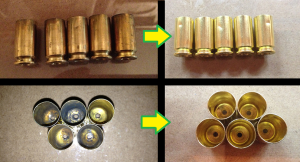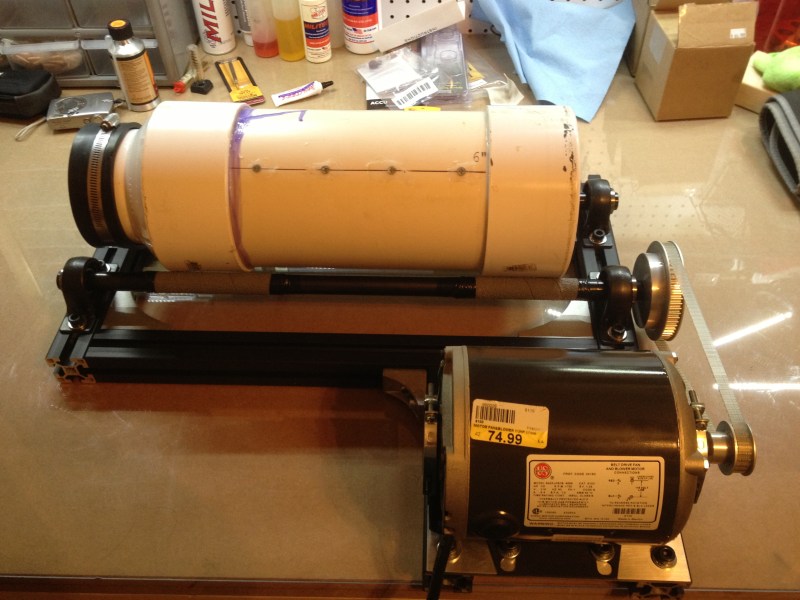Part tumbling is a method of deburring and cleaning relatively small objects. This is done by capturing the parts and media inside a rotating container. The agitation continually moves the media around all surfaces and corners of the part, smoothing them out resulting in a uniform finish. The media can be anything from specialty ceramic shapes to ball bearings to even sand. This process can be done in either a wet or dry condition. Think about the beach, the rocks there are smooth. This is due to the waves repetitively rubbing together the sand and stones which result in smooth round shapes.
[imp22b] recently got into ammo reloading and needed a way to clean his used shell casings. The casings are brass and after a little research online, [imp22b] found that a wet tumbling process with stainless steel pins for media was a DIY proven method for this casing material. He then went on to find a commercially available tumbler to model his build after, in this case a Thumler Model B. There is certainly no need to re-invent the wheel here.
As you can see in the photo, aluminum extrusion was used as the frame. Mounted to the frame are 4 pillow block bearings with shafts between each pair. A motor drives one of the bearing-mounted rods which in turn rotates a container resting on the rods. [imp22b] started with a 1/15 hp motor that he had kicking around but that wasn’t powerful enough so he did have to step up to a 1/3 hp unit. The container is made from off the shelf PVC pipe pieces and holds the media and casings along with some water. A bit of Lemon Shine and Dawn detergents are also added and help clean the parts. After a few hours of tumbling, the casings look pretty darn good.

If you’re interested making your own simpler tumbler, check out this one that uses a hand drill or this one that uses a coffee can.
















as non-native, why not “cleans your parts _well_”? (sorry, honest question)
Might just be to add a bit of colour. A little rough ’round the edges, like the build.
Allrighty, will read that from now on in a mental hillbilly voice.
That would be more betterer english, but hey, english is prone to bastardisation, and so stacks of folks use good. No worries either way. /Aussie accent
Nahh yeah, I think you’re onto something mate.
I prefer “cleans your parts REAL GOOD”
I would not trust that thing to clean my parts at all.
This tumbler has taken my memories back 40 years… my dad built a unit much like this one in the early 70s that used two junked IBM typewriter platens and motor on a wooden baseboard. We used to polish decorative stones by putting them in a glass jar with some carborundum powder and some liquid – could have been water, or light oil, I don’t remember – and running them on the tumbler for a few days after which the stones would come out all beautifully rounded and polished, it worked a treat. I can still recall the sound of the stones tumbling, sounded like cement in a cement mixer.
If it had been me, I’d have orientated the bolts holding the mixing blades the other way so that the heads are flush inside. These long bolts sticking out in the inside, doubtlessly hitting the parts to clean, can’t be the best solution.
I agree but it is a hack, and if he uses if for a long time the bolts might just be polished down to nubs.
Exposed, unguarded drive belt. :(
Agreed, though in this particular case it probably isn’t too dangerous. It looks like a soft rubber belt, and tumblers operate slowly. An adult’s fingers could probably go through that with minimal damage, though it might be more dangerous for small children (isn’t everything?).
Don’t get me wrong, I am an advocate of belt/chain safety and have the missing fingertip to show for it. I just wouldn’t be too worried about this particular belt.
More important, I think, is the fact that this isn’t a machine you interact with while it’s running. Exposed belts are a huge problem for factory or workshop machinery, but for something like this you can maintain perfect safety through the simply expedient of staying the hell away from it while it’s running.
We always just used large mayonnaise jars whenever we needed a tumbler when I was young. I’ve also used a peanut butter jar, and a cordless drill powered through a variac in previous tumbler designs.
Tumbling brass with metal media will drastically shorten their life, this work hardens them. Crushed walnut or corncob is the only really safe media. After tumbling a few million….
So are there any pictures of theses stainless pins referred to as “media”
google image search for “tumbling media stainless”
Very poor method of cleaning brass. Best way to do it is with ultra-sonication no media to wear out and it will also clean the primer pockets. Like Gavin stated you do not want to be using something harder than the brass to clean it, especially if you want to get maximum life out of the brass.
Other than that this would serve great as a ball mill with alumina ball bearings to grind anything from german dark aluminum to black powder.
LOL, you obviously have no clue about how to clean carbon off brass, ultra sonic cleaners don’t clean as effectively as SS media, and it never wears out and cleans the primer pockets 100x better than ultra sonic ever does in way less time. It also doesn’t wear out the brass.
I would add that even if (however unlikely) this would shorten the brass’s life resizing and firing is what affects the life of the brass.
If you use large enough ball bearings, you have what’s called a ball mill. This will end up pulverizing anything if left in long enough. I don’t know how well this would work with a PVC drum though. Cleaning brass as Gavin Melville mentioned is correct. I’ve reloaded for over 40 years, corn cob and walnut shells are the media of choice except in extreme cases. Choose your media carefully for whatever your trying to clean. There is a wealth of information for this on the web.
And when he’s done cleaning his casings, he can tumble his own black powder!
I “built” one of thee for my other half’s jewellery making, it was basically a gutted inkjet printer with a variable voltage reg to power the feed roller motor. Printers are pretty good donors for this – very easy to find discarded and they have a motor, PSU and usually a pair of nice (hardened) rollers spaced apart all ready to go.
Ooh, great thinking 99, I’ll have to stop half way next time I slavage a printer
I am imagining how loud that would be…
How can I obtain plans and parts list. Need to have speed controlled motor for slow speed grinding if used as ball mill.
Please send plans and parts list